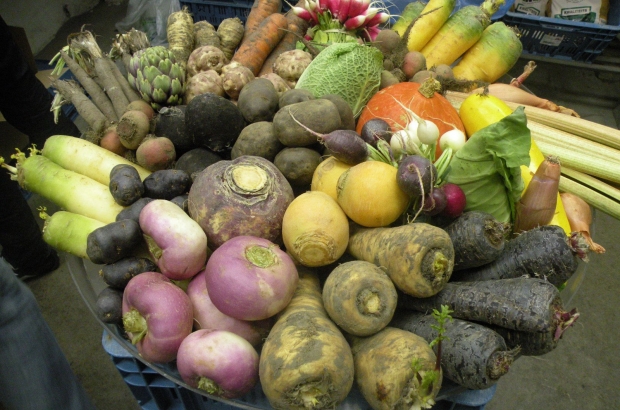- Daily & Weekly newsletters
- Buy & download The Bulletin
- Comment on our articles
5 forgotten winter vegetables and what to do with them
Finding your fridge stuffed with odd-looking forms that you suspect are vegetables but have no idea what they’re called or what to do with them? You may be looking at some of Belgium’s “forgotten vegetables”, the former staples of Belgian pantries and vegetable gardens which at some point over the last 70 years of increasingly industrial food lost a popularity contest to a handful of easily marketable, easily shippable crops (I’m looking at you, potatoes and carrots).
A lot of the list of forgotten vegetables is made up of winter crops. And the truth is, it’s easy to see why many of these old vegetables lost out. They’re greys and blacks and browns, they’re strange, inconsistent shapes and sizes and nearly impossible to peel.
But while winter vegetables may not be as flashy as many of their warmer-weather cousins, they carry a nutritional punch. Many of these ugly tubers and taproots are veritable superfoods, packed full of proteins, potassium, calcium and iron, and with enough vitamins and minerals to get you through the darkest months in strength and good health.
Here’s our list of five forgotten veggies you should try…
1. Scorzonera
At first glance, scorzonera, also called black salsify (Dutch: schorseneer; French: scorsonère), is not much to look at: a long, black or dark brown taproot, usually caked with dirt. But, once cleaned up and peeled, it has a surprisingly rich flavour and taste reminiscent of oysters, and it carries a slight sweetness that means it pairs well with cooked apples or other sweet side dishes.
Growing contently through Belgium’s coldest months, classically scorzonera has been treated as a sort of poor man’s asparagus. It is traditionally prepared in a similar way, by being peeled and boiled and served with a simple butter sauce and topped with parsley.
These days, more frequently you’ll find it cut into pieces and drenched in a thick beurre manié sauce served with potatoes. It is also occasionally battered and deep-fried, presented as a sort of croquette to accompany a main dish. Coquinaria details a few different ways to prepare this sweet, mellow vegetable.
2. Black radish
Only in winter do you get such an array of black vegetables. These sweet but biting radishes (Dutch: rammenas; French: radis noir, radis d’hiver) may look uninspiring, but they’re actually one of winter’s delights.
The colour of charcoal on the outside and a clean, nearly transluscent white on the inside, they have a bit less bite than a typical red radish and are great grated raw over salads, in a tabouleh, or simply thinly sliced with a mandolin and sprinkled with sea salt, olive oil and cracked pepper for a fresh vegetable carpaccio.
If you’re looking for something heartier, try roasting them. Follow Brooklyn Supper’s recipe for quinoa with roasted black radish and grapes for a warm, filling meal.
3. Jerusalem artichoke
Perhaps the ugliest root on the list, the Jerusalem artichoke (Dutch: aardpeer; French: topinambour) looks more like ginger root than anything to do with an artichoke. And it comes from the Americas, not Jerusalem. But it’s an excellent replacement for potatoes when you’re tired of the more typical tuber.
You can roast them, mash them, fry them. Their sweet, slightly nutty taste is a nice change from the potato. Jamie Oliver likes to sautée them with garlic and bay leaves, but be creative.
4. Winter purslane
Finally, a green vegetable! This hardy little leafy green manages to grow through the iciest of Belgian winters. The soft, slightly acidic, spinach-like taste of winter purslane (Dutch: winterpostelein; French: pourpier d'hiver, claytone de Cuba) makes it a perfect addition to any fresh salad. Or it can be eaten warm by steaming it for a minute or two, or throwing it in at the end of any wok meal.
As a leafy green, it is filled with health perks, from vitamin C to ward off a cold to significant amounts of magnesium and iron to keep you happy and strong throughout the winter.
5. Root parsley
While it looks similar to a parsnip, root parsley (Dutch: wortelpeterselie; French: racine de persil) has a totally different taste – one, not surprisingly, more akin to parsley. And so it is parsley, just a particular species of the herb that produces thick, edible, carrot-like roots.
Most frequently, you’ll find root parsley in soups, lending a clearly identifiable parsley flavour. Often it will be blended with celeriac to make a creamy soup. Some find the combination enchanting, others overwhelming – but it’s worth a try.
However, like carrots, parsnips and the like, it is a versatile vegetable. If you find the parsley taste too much to handle in soup form, try roasting them with other root vegetables in the over with a bit of olive oil, salt and pepper. Or try My New Roots'srecipe for parsley root fries and homemade ketchup.
Photo courtesy of Aopsan / freedigitalphotos.net



















Comments
Marvellous, a really useful article, thank you.